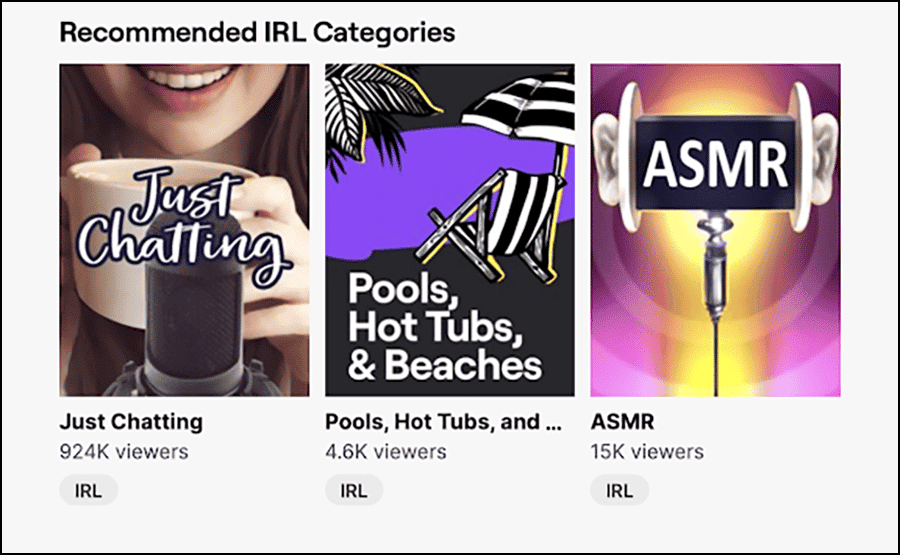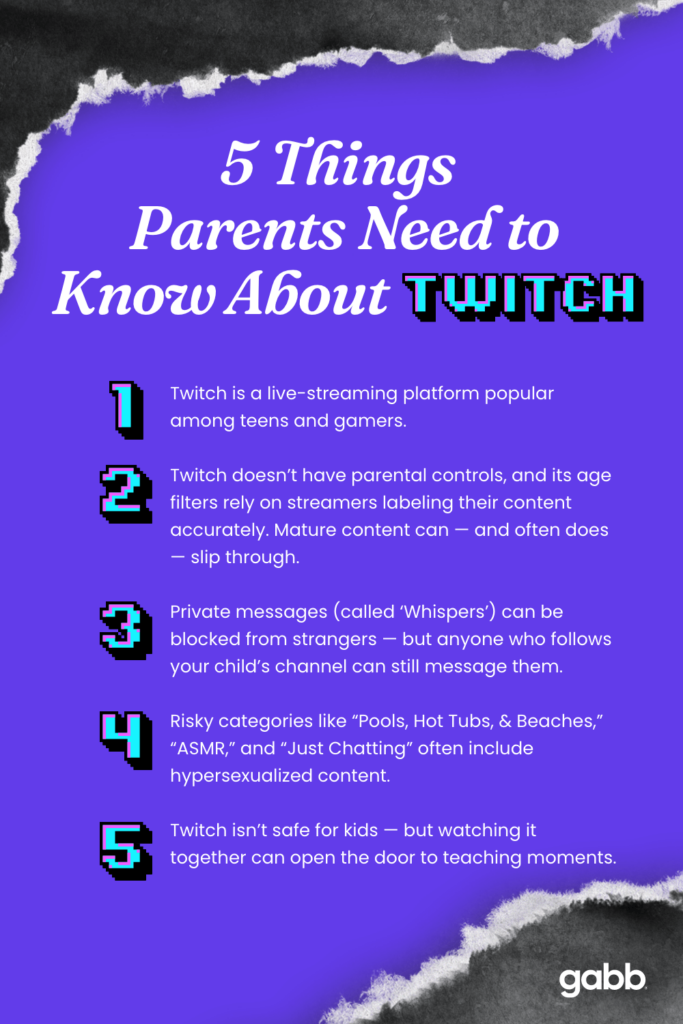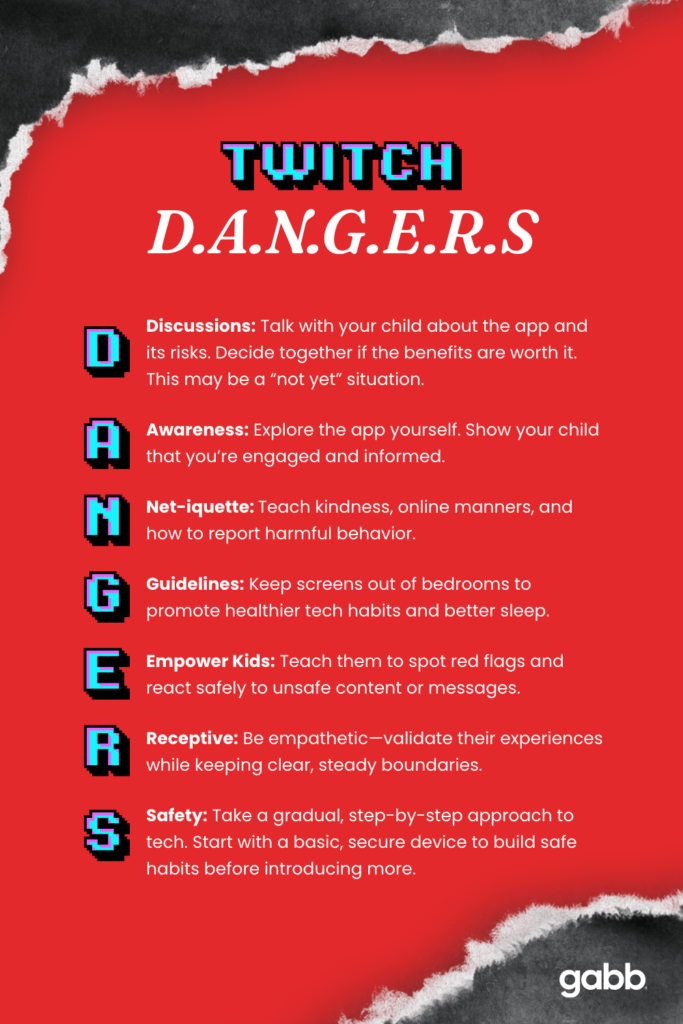Updated – Originally published December 15, 2023
It can be tough to keep up with the latest apps our children and their friends use
You’re likely familiar with TikTok, Instagram, and Snapchat, but what do you know about Twitch?
Any social platform comes with risks, but the platform has some unique features that make Twitch unsafe for kids.
🎧Twitch streams live, preventing any delay to moderate content.
🎧 Child sex abuse material is easily live streamed.
🎧 Twitch’s age verification system is easily bypassed.
🎧Twitch allows users to send private messages called “whispers”.
What is Twitch?
Twitch is a social media platform that specializes in live streaming.
It’s easy to broadcast almost anything, including cooking, playing music, doing homework, or hanging out at the pool (more on that later).
One of Twitch’s most popular content categories, Just Chatting, is simply videos of people talking about whatever is on their minds, like a talk show.
That said, Twitch’s streaming service is centered on video games. Anyone can stream themselves playing and millions of users spend hours watching other people play.
Twitch attracts around 35 million viewers every day
– Backlinko
It may be hard to imagine why kids would want to watch someone else play video games, but the appeal is huge for gaming community members.
Like how you might follow your favorite sports players or celebrities, Twitch users enjoy following their favorite streamers.
What Is Twitch Intended to Do?
One of Twitch’s biggest draws for users is its live streams. It’s similar to YouTube because it’s a massive repository of user-generated content (UGC).
The difference is that most of Twitch’s content is streamed live.
This streaming platform allows like-minded individuals to meet, chat, and create media together. However, a lack of robust age-verification means that predators can easily contact children.
Every video has a public chat board that lets viewers talk to each other and the person streaming.

You can also connect with other Twitch users, whether you know them or not, by sending private messages called “whispers.”
These opportunities to connect with others have the potential to lead to positive social change, break down barriers between different groups, and educate individuals.
Unfortunately, they can also reinforce stigmas, create contention, and spread misinformation at exponential rates compared with traditional media.
How Twitch Makes Money
Like the business models of most social media platforms, Twitch earns money through ads—they sell children’s data to companies that can then target consumers. Whenever a user clicks on a video they want to watch, an ad plays before taking them to their video.
It’s the same model you see on YouTube. Users can skip the ads by paying for a premium version of Twitch.
Twitch Privacy
Twitch collects data about its users to send them more personalized ads. They justify using this data by claiming they intend to “manage relationships with Twitch account holders (e.g., Partners, Affiliates), including making or receiving payment.”
In other words, they sell that data to interested parties. Online privacy is important when considering a child’s safety.
Dangers of Twitch Streaming
Exposure to violent media has been shown to increase aggression in children and escalate the chances of viewing violence as a legitimate course of action when confronted with challenges.
Repeated exposure has been shown to affect kids’ brains by normalizing violence in these “lessons”.
Twitch contributes to this problem.

In the tragic Buffalo grocery store shooting on May 14, 2022, the perpetrator brazenly live-streamed himself shooting people for two minutes before the video was removed.
That was enough time for the video to be seen and reshared by millions of online viewers across multiple social media platforms.
Twitch “Clips” Feature Used to Exploit Kids
In early 2024, a disturbing investigation by Bloomberg News revealed that predators have been using Twitch’s “Clips” feature to exploit children. This feature allows users to save short, seconds-long segments from livestreams and share them widely—both inside and outside of Twitch. This resulted in the sharing of child sex abuse material (CSAM).
According to the investigation:
- At least 83 clips featured sexualized content involving minors
- 34 clips showed young children — mostly boys ages 5 to 12 — exposing themselves on camera, often while responding to viewer prompts during livestreams
- Another 49 clips included grooming behavior or children being sexualized
- These videos were viewed a combined 10,000 times before being removed
- Some were downloaded using browser extensions and could be circulating permanently elsewhere, including on the dark web
The Canadian Centre for Child Protection reviewed the content and confirmed the harm. While Twitch removed the flagged clips once notified, sources inside the company said the “Clips” feature is still one of the least moderated areas of the platform.
Twitch’s growing emphasis on short-form video — similar to TikTok — makes it even easier for predators to find and share inappropriate content. The company says it’s investing in safety tools, but for families, this incident reveals how even brief, seemingly harmless moments on livestreams can be recorded, edited, and weaponized.
Twitch Exposes Viewers to Violent Video Game Content
Twitch doesn’t seem to have a problem with streaming video game violence. Since the app contains content on almost all video games, young users can watch people playing highly-graphic games like Soldier of Fortune, Mortal Kombat, and Grand Theft Auto.
Sexual content on Twitch
Sexual media hurts kids—both boys and girls, and their ability to have healthy relationships with others.
Research suggests that children exposed to sexual content, especially violent sexual content, experience higher rates of aggression, sexist beliefs, sexual violence, and objectification of others.
Burnay & Bushman
In December of 2023, Twitch updated its policy on sexual content only to switch it again just days later. The platform claimed it did so in an effort to bring more consistency, but in reality all it did was loosen their restrictions across the board.
Per their own guidelines, Twitch made a change to allow the following content as long as the stream had a Content Classification Label (CCL):
- Content that ‘deliberately highlighted breasts, buttocks or pelvic region,’ even when fully clothed.
- Fictionalized (drawn, animated, or sculpted) fully exposed female-presenting breasts and/or genitals or buttocks regardless of gender.
- Body writing on female-presenting breasts and/or buttocks regardless of gender.
- Erotic dances that involve disrobing or disrobing gestures, such as strip teases.
Shortly after the change was announced, Twitch’s art category was inundated with AI-generated photorealistic nudes, causing many in the community to complain. Per TechCrunch, just days after Twitch’s sweeping update was announced, “depictions of both real and fictional nudity are banned on Twitch again [but] streamers will still be able to show nudity in Mature-rated games.”

Even though Twitch’s community guidelines prohibit “sexually explicit content or activities,” the reality is that the platform is rife with sexual content. It can be found in abundance through gaming streams of titles like VRChat and Dead or Alive Xtreme 3.
Beyond users easily finding explicit content through game streams, including nudity and sexual acts, you can also find links to adult websites from other users in chat and streamer bio pages.
Mature content on Twitch: What is ASMR?
Watching video game streaming on Twitch is not the only way to view mature content. Twitch has a category for explicit channels called ASMR.
Some content on ASMR channels is perfectly fine, like the sounds of nature. However, this channel also features videos of people in revealing clothing making sexual sounds into their microphones—content inappropriate for developing minds.
ASMR: Twitch’s Secret Sexual Shows
- Definition: Autonomous Sensory Meridian Response
- Purpose: To relax and soothe viewers
- Innocent Examples: Rain on windows, a crackling fire, or bird calls
- Threatening Examples: ASMR videos featuring hypersexualized women making erotic sounds
Pools, Hot Tubs, and Beaches
Twitch also promotes the category “Pools, Hot Tubs, and Beaches,” in which women in bikinis talk with the chat.
Since these videos are watched live, viewers may even pay their favorite streamers to perform certain requests—such as writing their names on their bodies, giving them a shoutout, or wearing particular outfits.

Having sexual content on the platform is bad enough. However, when requests can be bought in a hyper-sexualized environment, boys and girls learn that such behavior is normal and acceptable—and even for hire.
Objectification of women and no parental controls
Many Twitch streams—especially in categories like “Pools, Hot Tubs, and Beaches” or suggestive ASMR—emphasize appearance, body parts, and viewer-paid interactions over meaningful content. This type of UGC promotes the objectification of women, viewing them as objects to be enjoyed rather than human beings deserving of respect.

Twitch automatically filters out streams labeled with sexual themes, violence, or substance use (typically due to the content of the games being streamed) for underage accounts or viewers who aren’t logged in. However, Twitch does not offer any parental controls to prevent children from bypassing these filters and viewing these problematic streams or any other type of inappropriate content.
Chatting with strangers
Twitch’s most enticing aspect is also its most dangerous—meeting, befriending, and interacting with new people online.
The chat feature can be useful among adults, but it is inherently dangerous when children use it. On Twitch, this can happen in public chats or private messages.
90% of sexual advances against children occur in internet chat rooms or through instant messaging platforms.
FBI, 2024
Predators often groom victims by pretending to have common interests and being sympathetic.
Twitch simplifies this process because the perpetrators have an immediate shared interest to talk about —the live stream the child is watching.
The barrier of time needed to find common interests is removed for the predator by this platform.
How to Block Twitch “Whispers” From Strangers
Strangers on Twitch can send private messages called “whispers.”
Here’s how to turn them off:
- Click on your Profile
- Open Settings
- Click Security and Privacy
- Toggle on “Block Whispers from Strangers”
⚠️ “Strangers” only means users who aren’t followers, subscribers, mods, or editors. So if someone follows your child’s account, they can send them private messages. This setting reduces random spam, but it won’t prevent bad actors from initiating contact if they click “follow” first. And it’s possible for kids to unblock “whispers” without their parents’ knowledge.
Profanity, vulgarity, and hate speech
Inappropriate language can come from the streamers or viewers using the chat function.
While some streamers create clean content and enable chat filters that keep profanity and hateful language from being posted, many do not.
The chat function on Twitch cannot be disabled completely, so kids will always be able to see other people’s inappropriate comments.
Wasting time
All children and adults are exposed to Twitch’s least frightening risk — —general time-wasting.
Twitch can be hard to walk away from, and users can easily spend hours watching videos as life passes them by.
More time on screens means less human connection for all of us.
The Dangers of Live Streaming
Live streaming removes the filters that typically protect young users. When kids go live, there’s no delay, no moderation, and no second chance. Inappropriate moments—whether accidental or manipulated by viewers—can be clipped, shared, and spread instantly.
Even when kids are just watching streams, the real-time nature of Twitch creates unique dangers. Viewers can interact in the moment, make paid requests, and message streamers directly—sometimes grooming them over time. Twitch’s live chat, combined with features like “Whispers” and “Clips,” means that a single bad interaction can have long-lasting consequences.
For parents, the takeaway is this: live content moves fast, and Twitch doesn’t move fast enough to keep up with it.

So… Is Twitch TV Safe for Kids?
According to the platform, Twitch is unsuitable for children ages twelve and under.
The app prohibits children younger than 13 years old from using it in its own Terms of Service. However, a user’s age is not verified when signing up, making their recommendation trite.
Consider opening Twitch on your own device to see how long it takes for a stranger to make contact. It’s a powerful illustration of the risks—and helps you stay in the know.
Twitch recommends that children between 13 and 18 (in most states) be supervised while using the app.
If a child has access to Twitch, it’s important to view and discuss the content with them, but most parents are unlikely to have the capacity to monitor their children’s Twitch use closely enough to keep them safe.
For these reasons, Twitch is not safe for kids.
Empowering Kids with Conversations: Viewing Twitch Together
As parents deem appropriate, sitting with kids and talking about the explicit content they will be exposed to on Twitch will protect them in a long-lasting way.
As you view Twitch together, consider asking questions such as:
- What message is this content trying to send? What do you think about that message?
- What effect do you think this video has on your mind and heart?
- What do you think is motivating this streamer to create this video?
- What features of this platform could be dangerous for young users?
By setting a boundary prohibiting Twitch, we can empower our kids to not to allow the platform and bad actors to exploit them.
Advice for Families
At Gabb, we believe in Tech-in-Steps—introducing technology slowly, safely, and in age-appropriate phases. Platforms like Twitch vault kids ahead to content and interactions they’re not developmentally ready for. Choosing tech that grows with your child helps protect their mind, relationships, and confidence.
If parents decide to allow their children to set up a Twitch account, we recommend they follow the app’s guidelines and watch over their kids while they use the app.
The following suggestions can help parents guard against Twitch risks.

What You Probably Googled
Hopefully we answered your questions above. But here are a few things you might have googled to get here—along with some quick answers.
What is Twitch?
Twitch is a live-streaming platform where people broadcast themselves playing video games, chatting, doing art, or just hanging out. It’s owned by Amazon and draws over 35 million users a day. While popular with teens, it’s also home to mature content that isn’t filtered well for young viewers.
Age minimum Twitch?
The official minimum age to use Twitch is 13. But because there’s no real age verification, younger kids can easily create accounts—and even without one, they can still watch streams. That means children can be exposed to mature content, graphic games, or sexualized material without any barriers in place.
Is Twitch appropriate for 10 year olds?
Definitely not. Kids this young are especially vulnerable to inappropriate content and online grooming. Even “just watching” streams can expose them to violence, nudity, and sexual behavior in games or chats.
Is Twitch safe for 12 year olds?
No. Twitch doesn’t verify age, and many 12-year-olds use it despite the policy. This group is especially at risk for exposure to explicit content, strangers in chat, and even predatory behavior through features like “clips” and live messages.
Is Twitch appropriate for 13 year olds?
Technically, yes—13 is the minimum age to use Twitch. But that doesn’t mean it’s safe. Even with supervision, 13-year-olds can encounter sexualized content, hate speech, and stranger interactions. Most parents would find it inappropriate without active oversight.
Is there porn on Twitch?
Not officially. Twitch bans pornography, but sexualized content is still easy to find. Categories like ASMR or “hot tub” streams often blur the line, and adult links sometimes appear in chats or streamer bios. It may not be explicit porn—but it’s close enough to raise concern for any parent.










Success!
Your comment has been submitted for review! We will notify you when it has been approved and posted!
Thank you!